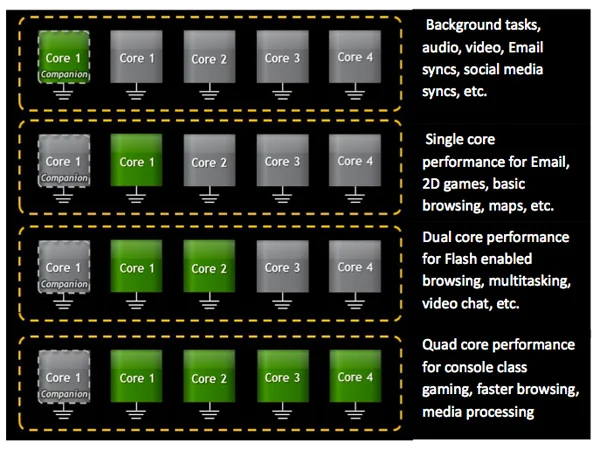Nvidia has published detailed specs about the fifth core in its next-gen Tegra processor.
According to company rep Matt Wuebbling, Project Kal-El’s fifth core is referred to internally as a “companion core” – which runs at a lower frequency and operates at exceptionally low power.

“During less power-hungry tasks like web reading, music playback and video playback, Kal-El completely powers down its four performance-tuned cores and instead uses its fifth companion core,” Wuebbling explained in an official blog post.
“For higher performance tasks, Kal-El disables its companion core and turns on its four performance cores, one at a time, as the work load increases.”
Wuebbling added that the variable SMP architecture is “completely OS transparent,” meaning, operating systems and applications don’t need to be redesigned to take advantage of the fifth core.
Meanwhile, Nvidia exec Mike Rayfield noted that Kal-El consumes less power than dual-core chips from Qualcomm, TI, as well as Nvidia’s own Tegra 2 processor.
“Anything any dual core can do…I do it better with lower power in my quad core. It really did come into a lower power envelope than a dual core and much higher peak performance,” Rayfield told the WSJ.

“[Regarding the fifth core, well, the] other cores are high-speed cores… They burn more power, but you only turn them on when you need them… If that fifth processor turns on and burns even less power than anything else, then your average power for the use case goes down.”
Of course, as Anand Lal Shimpi points out, the five A9 cores can’t all be active at once, so you either get 1 – 4 of the GP cores or the lone LP core.
“Nvidia expects pretty much all active work to be done on the quad-core GP array, it’s really only when your phone is idle and dealing with background tasks that the LP core will be in use,” he said.
The 40nm Kal-El – which is expected to hit tablets in late 2011 and early 2012 – also boasts a 12-core GPU capable of delivering up to 3x the graphics performance of Tegra 2.
Additional information about Kal-El can be found in two Nvidia whitepapers here and here.






